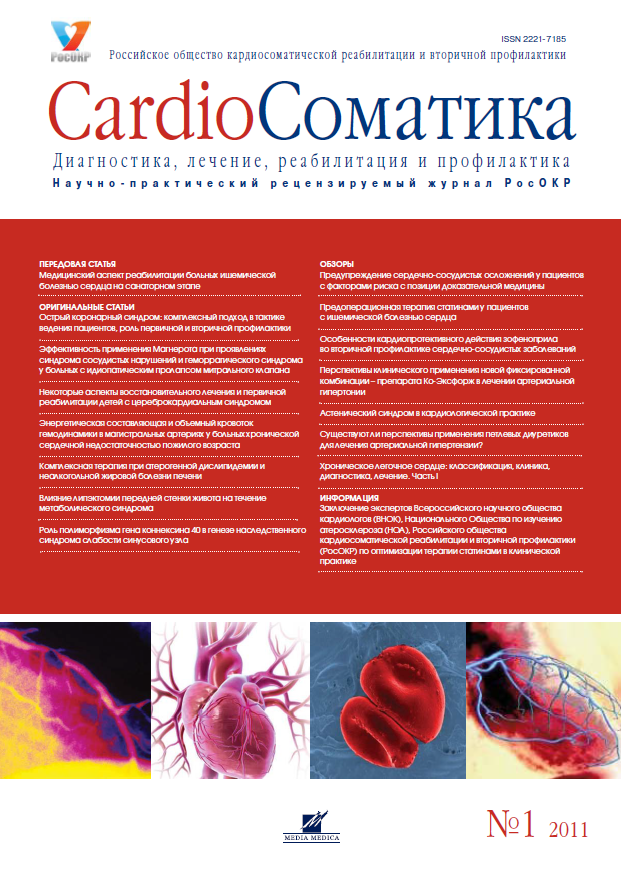Vliyanie lipektomii peredney stenkizhivota na techenie metabolicheskogosindroma
- Authors: Volokh M.A.1, Khalimov Y.S.1, Shapovalov V.M.1, Gubochkin N.G.1
-
Affiliations:
- Issue: Vol 2, No 1 (2011)
- Pages: 37-41
- Section: Articles
- URL: https://cardiosomatics.ru/2221-7185/article/view/44964
- DOI: https://doi.org/10.26442/CS44964
- ID: 44964
Cite item
Full Text
Abstract
Summary. Objective: to study the influence of surgical correction of abdominal obesity in patients with type 2 diabetes
mellitus on clinical course of metabolic syndrome (MS).
Design and methods: 181obesity and type 2 diabetes mellitus patients were studied. All patients were divided into
two groups.
First group consisted of 109 patients, who underwent lipoaspiration or abdominoplasty with subsequent medication.
Second group - 72 patients suffering from abdominal obesity and type 2 diabetes mellitus, were treated conservatively
without surgery.
MS was diagnosed by six criteria in 90 (82,5%) first group patients and in 57 (79,1%) second group patients. 19
(17,5%) patients in the first group and 15 (20,9%) - in the second had five diagnostic MS criteria.
Results. The study of patients serum lipid structure shows different results depending on the treatment technique. Anterior
abdominal wall lipectomy leads to much faster and significant improvement in main lipidogram features, especially
triglyceride and low-density lipoprotein concentration, which are the most important markers of MS progression.
Unlike patients with obesity and type 2 diabetes mellitus treated conservatively with medication, surgically treated
patients show fast and resistant improvement in cardonhydrate metabolism compensation markers, which are
decrease of serum fasting glucose and glycated hemoglobin levels.
Arterial hypertension stage II and III in the first group patients developed significantly less in 5 years after surgery
(р<0,05), and arterial hypertension stagу I - significantly more.
Conclusion. Surgical correction of abdominal obesity has improves clinical course of metabolic syndrome due to
normalizing carbonhydrate and lipid metabolism. This positive influence are more evident in stage 1 or 2 obesity
patients. Anterior abdominal wall lipectomy decelerates the arterial hypertension progression.
mellitus on clinical course of metabolic syndrome (MS).
Design and methods: 181obesity and type 2 diabetes mellitus patients were studied. All patients were divided into
two groups.
First group consisted of 109 patients, who underwent lipoaspiration or abdominoplasty with subsequent medication.
Second group - 72 patients suffering from abdominal obesity and type 2 diabetes mellitus, were treated conservatively
without surgery.
MS was diagnosed by six criteria in 90 (82,5%) first group patients and in 57 (79,1%) second group patients. 19
(17,5%) patients in the first group and 15 (20,9%) - in the second had five diagnostic MS criteria.
Results. The study of patients serum lipid structure shows different results depending on the treatment technique. Anterior
abdominal wall lipectomy leads to much faster and significant improvement in main lipidogram features, especially
triglyceride and low-density lipoprotein concentration, which are the most important markers of MS progression.
Unlike patients with obesity and type 2 diabetes mellitus treated conservatively with medication, surgically treated
patients show fast and resistant improvement in cardonhydrate metabolism compensation markers, which are
decrease of serum fasting glucose and glycated hemoglobin levels.
Arterial hypertension stage II and III in the first group patients developed significantly less in 5 years after surgery
(р<0,05), and arterial hypertension stagу I - significantly more.
Conclusion. Surgical correction of abdominal obesity has improves clinical course of metabolic syndrome due to
normalizing carbonhydrate and lipid metabolism. This positive influence are more evident in stage 1 or 2 obesity
patients. Anterior abdominal wall lipectomy decelerates the arterial hypertension progression.
About the authors
Mariya Aleksandrovna Volokh
Yuriy Shavkatovich Khalimov
Vladimir Mikhaylovich Shapovalov
Nikolay Grigor'evich Gubochkin
References
- Argiles J, Lopez-Soriano J. Journey from cacheria to obesity by TNF. Faseb J 1997; 10: 743-6.
- Bristow S, Rawan J, Rush E. Obesity and gestational diabetes mellitus: breaking the cycle. N Z Med J 2009; 122: 12-9.
- Ford ES. Prevalence of the metabolic syndrome among US adults. JAMA 2002; 283: 356-9.
- Haffner S, Lehto S, Ronemma T, Pyorala K et al. Mortality from coronary heart disease in subjects with type 2 diabetes and in nondiabetic subjects with and without prior myocardial infarction. N Engl J Med 1998; 339: 229-34.
- Liebl A. Complications, co-morbidity, and blood glucose control in type 2 diabetes mellitus patients in Germany - results from the CODE2 study. Exp Clin Endocrinol Diabetes 2002; 110: 10-6.
- Mantzoros C. Leptin and the hypothalamus: neuroendocrine regulation of food intake. Mol Psychiatry 1999; 4: 8-12.
- Winocour PH, Kaluvya S, Rasmatyia K. Relationship between insulinemia, body mass index and lipoprotein composition in healthy, nondiabetic men and women. Arterioscler and Thromb 1998; 12: 393-402.
Supplementary files








